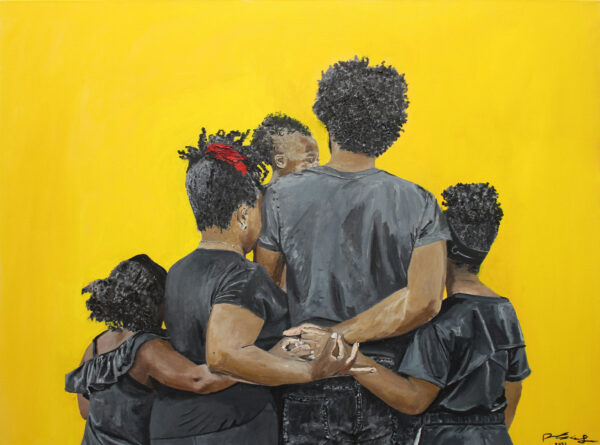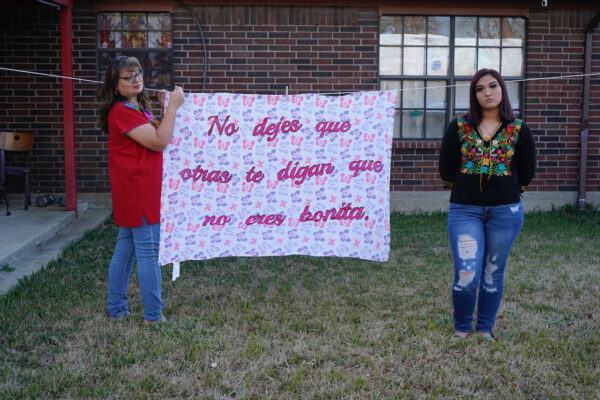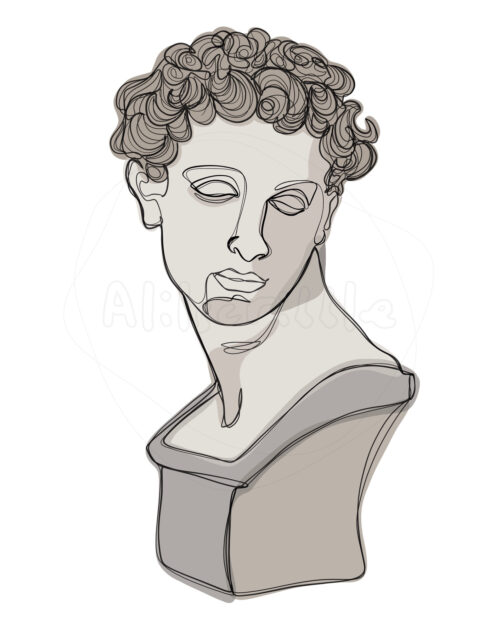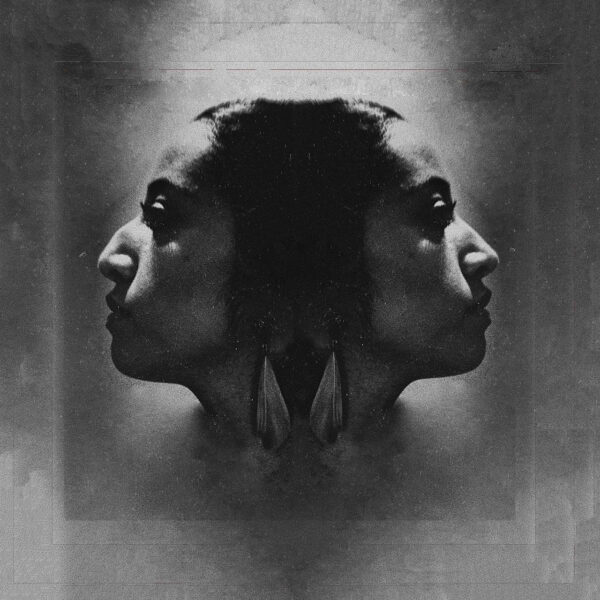
Raul Rene Gonzalez, “Together (Photographer Anthony Francis & Family),” 2021, oil on canvas, 30 x40 inches. Image provided by Lauren Cross.
This year’s Contemporary Art Month (CAM) Perennial Exhibition, titled Interior Realities, showcases work from 17 San Antonio artists and will be on-view at two locations: Sala Diaz (from March 10–April 20) and the Southwest School of Art (from March 5–April 6). Every year during the month of March, as part of its mission, CAM offers a platform for artists, performers and curators to show off all the artistic creativity San Antonio has to offer at galleries, museums, performing arts spaces, schools, artist studios, and various unconventional locations across the city.
This year’s CAM exhibition is guest-curated by Lauren Cross, PhD, who is the Program Coordinator and Assistant Professor of Interdisciplinary Art and Design Studies at the University o North Texas’ College of Visual Arts & Design. Cross is an interdisciplinary artist/filmmaker, curator, and scholar whose work (including her feature film The Skin Quilt Project) has been screened and exhibited across the country. Cross curates exhibitions in her own community and she is the founder and chief curator of WoCA Projects, a non-profit artspace organization in Fort Worth, Texas. Focusing a lot of her attention on the topic of identity in art, Cross incorporates these types of conversations in both her personal and curatorial work. In our interview below, Cross reflects on her curatorial practice and goal of looking for opportunities to transform the art world, diversifying how we think about our practice, and owning conversations in new ways.
Ashley Allen (AA): What was your process and experience like curating the Contemporary Art Month 2022 Perennial exhibition?
Lauren Cross (LC): To start, one of the major things I considered was the mission of Contemporary Art Month. It is one of the premier art exhibitions that really highlights and showcases what’s happening in San Antonio’s contemporary art scene. That was the starting point for me, to think about the significance of this particular exhibition and then, building off of that, how I could highlight certain aspects of what I saw with the artists that I met. My role as the guest curator was to look at the pool of artists that applied for the opportunity and then to select a short list of artists to interview and conduct studio visits with. Then, I selected the final group of artists for the actual exhibition. For the CAM perennial, there is more than one exhibition venue — Sala Diaz and the Southwest School of Art. This collaboration created an opportunity for me to think about two different types of spaces in San Antonio and how two different types of conversations are created that could also be somewhat linked together. That’s how I approached it, thinking about some of the things that the selected artists are interested in and dealing with in their work and trying to see where I could build the relationship across the artists and their conversations. That series of steps is what I did, and then obviously in the final selection of artists, I decided who to exhibit at Sala Diaz versus at the Southwest School of Art.
AA: How did you work with the participating artists to decide what artworks to include in the Perennial?
LC: I like to approach curating as if I’m in a partnership with the artists. It’s not necessarily me saying “I want this, this and this,” but instead having a conversation with the artist to confirm and see what works they actually had available. Then we had a conversation about how many works, if there was a body of work, and what works would be available at the time of the exhibition. After that, I confirmed what the artists had available and some artists were interested in making new pieces, so in that case I needed to check-in and make sure that that was still the case. It really depends on each specific artist and what they were thinking about in the process.
AA: How does seeing a work of art in an artist’s studio beforehand affect how you view it and arrange it in the gallery space?
LC: That’s a great question. In this particular case, we did virtual studio visits, so it’s not necessarily me seeing works in person but seeing them virtually, and it’s not abnormal or unusual to make selections like that in the curatorial process. A lot of the sort of arranging and selection in terms of the layout and exhibition design will actually happen mostly on-site when I help with the install. Once I have both a sense of the floor plan of each space and also the imagery that all of the artists have submitted, I can then take that and think about the conversation amongst artists and how each artist’s work speaks or has the potential to speak within a space. Having a prior experience of the spaces of Sala Diaz and Southwest School of Art gives me a sense of what I feel could work in the space. And then also, I’m thinking about how each artists’ work is speaking amongst each other because there is a relationship between artworks and how they speak next to each other. It is kind of a little bit of both coming in with the vision, but then also seeing whether or not it registers once you are there in the space with the works. At that point, if I need to make any changes, I can.
AA: Can you tell me a little bit about the two locations encompassing the CAM 2022 Perennial: Sala Diaz and Southwest School of Art?
LC: The location of each CAM Perennial changes for each iteration of the exhibition, and the relationship that CAM has with its local arts venues is really a partnership. The venues open up their spaces to say that they want to be a part of this conversation. As a result of seeing which organizations were interested in participating this year, there were two organizations who wanted to host; it sort of started with Sala Diaz and then extended into the Southwest School of Art. This created a unique opportunity to have this first kind of conversation across two spaces. I have had the opportunity to do this in the past — I helped co-curate a show that was in Fort Collins during the pandemic, a couple years ago now. It was the opportunity to curate a show that was housed basically in two different spaces. When this opportunity presented itself, I thought that this is actually not a bad thing! Now, number one, it provides an opportunity to work with more artists because each space has a limited amount of space or a maximum amount of space that you can work with. It gave me the opportunity to think about how — for technical reasons in terms of space itself — certain artists might fit within the smaller space of Sala Diaz and how some might fit better with Southwest School of Art, as it is a much larger exhibition space. The other thing concerning the spaces is that Sala Diaz has a history of being a space that provides resources and a communal center for artists. Then it became a matter of how I can curate with that in mind, thinking of Sala Diaz’s mission statement and thinking about how I could tie those artists together who are kind of talking about what it’s like to be an artist. That is how I look at it, as an opportunity to expand the conversation that I can see emerging. Like I said, it gives you an opportunity to work with different types of artists that you see doing related things, and it is a great opportunity to bring these artists together and have a conversation.

Gabriel García, “Layers 03,” 2022, part of the series “Sudden Anamnesis,” enamel on printed Gatorboard, 18 x24 inches, Image provided by Lauren Cross.
AA: Concerning this conversation between artists, can you elaborate a little on the title of the Perennial, Interior Realities, and how you came to choose this title?
LC: Yes, the title of the show itself really sprang from my conversations with the artists I chose for the show. Specifically, from speaking with them about the things that were behind their work and the things that they were interested in. There are different connections that I’m drawing between each artist, and I started to uncover an emerging theme I was drawn to. They are all talking about identity in different ways, some not so explicitly. But there are these relationships between identities … maybe like in big picture identity, meaning community identity and how that gets constructed and interpreted. On the other hand, there are artists who are thinking about their own identities. When I say identity, I am not only speaking about it in terms of a race, but also gender and social or cultural positions in society. So some artists were thinking about their relationship to being a parent, and about the fact that they have multiple roles that they play in life outside of being an artist.
There is this conversation about borders and boundaries and territories happening, and I’m drawing that relationship between many of the artists. Some of the artists were talking about literal borders and how that was affecting their sense of identity. That’s how the title Interior Realities really came about. It’s interesting that the idea of interiors can be described and interpreted in so many different ways. The idea that there are these different relationships that we have to space, to the environment, to our communities, and to interior spaces specifically, and how they all tend to be within this interior/exterior kind of relationship. As I was listening to each artist talk about what they were interested in and what was really on their minds, I was like, “Oh my gosh, everybody is talking about interiors in different ways.” It is also comforting too, because you want a sense that you feel like you are bringing together different minds, because everyone has a different perspective. But it is kind of a confirmation when you see artists saying “yeah, this is what I’m interested in,” and you start to see a thread develop. It is easy to get excited about that and it is really interesting that everybody is talking about this. It seems very relevant now and it becomes a question of how to capture and contextualize that idea in a way that helps others entering into the exhibition to understand that connection. I also always think about how the works read to a viewer and how the way that I position them in a space can assist in that interpretation process.
AA: What is something that you hope a viewer takes away from the show?
LC: I think there is a lot to celebrate. For one, these are all San Antonio artists and the Perennial presents a really awesome opportunity to support the local community. To walk in and see that these are San Antonio artists and that this is the work that they are making right now is relevant for a viewer; it allows them to step into that world and that conversation. That is part of it, and because I am really big about supporting local artists, I think visitors should come with that in mind. But then also the fact that these are artists who are concerned about different realms of reality in our world, whether it’s racial identity, gender identity, land/geographical identity, the identity of the artist — they are all interested in different aspects of our reality. So I think there is a lot that visitors from multiple backgrounds can enter into a conversation with and relate to. I anticipate the possibility that there are so many ways in which artists are speaking about this topic that you can go in anticipating there will be something you are going to relate to or that you might be interested in. That’s my hope. All of the artists do wonderful work and many of the artists are well-known in San Antonio, so these might be artists that people are already excited about. The awesome thing about this opportunity for me is that I get to work with these amazing artists that the community is probably already aware of; this is my opportunity to see what they’re working on and really highlight and celebrate them.

Gabi Magaly, “No dejes que otras te digan que no eres bonita,” 2022. Image provided by Lauren Cross.
AA: How does your own identity manifest itself in your curatorial work, if at all, with the Perennial and also with your nonprofit, WoCA Projects?
LC: I think if anything, it’s the recognition that different realities deserve a space to be heard. In terms of my curating, it has always been about how I can bring voice to different viewpoints. It’s not so much that it has to be one viewpoint over another, but it’s kind of similar to an ethnographer going into an environment and saying, ”What are the different experiences happening here and then trying to find a way to elevate what’s already happening.” I think also, as a researcher witnessing what each artist is developing in their practice and seeing that an artist is really onto something, I really want to find a way to highlight that.
Certainly, the history of my curating has always been about highlighting diverse voices from multiple backgrounds. Not one single racial group or ethnicity, but more thinking about how I can create a space where diverse conversations can happen across different realities. That’s always been my focus, because sometimes it does happen in the art world where there is a lot of the same thing happening repeatedly. I try to go into it thinking about all of the things that are happening and how can I have a well-rounded conversation about them; if there is anything that I bring in terms of my own personal identity and experiences, it is the awareness that multiple perspectives are important.
AA: How do you balance your own personal creative work as an artist with all of your curatorial responsibilities?
LC: A lot of it is basic time management and considering the things that are important enough to prioritize because there are only 24 hours in a day. Beyond compartmentalizing and time management, there are certain different hats that I wear depending on what I am doing. I’m an artist myself, but when I am curating, I try not to have my artist hat on, if that makes sense. Though I do feel like being an artist does help, because then I can have a conversation about the art making process that I’m not sure happens in certain other contexts; because I understand how to make art, I can bring that into the conversation to peel away what is actually happening. But, in terms of how I curate, I try not to say “this is the art that I like to make,” because it is not useful to carry that into a visit; but I definitely use my understanding of art making as a resource.
AA: Have you ever experienced any conflicts on your journey into the professional art world, and if so, how did you overcome these roadblocks?
LC: Yes, of course, there’s always pushback, that’s part of life. And it’s on so many levels, right? There is your identity, and that can be used by people to very personally oppose you, but then sometimes [the art world is also resistant to change]. It’s a question of how to work around that. I go about working through this by going into projects with the understanding that there could be lots of challenges. I don’t have a lot of naïveté about it, I kind of go into it with optimism, but I’m also realistic. Therefore, when the challenges arise, I try to figure out what I can do to assist them and move forward. Sometimes it is just a conversation, because sometimes it’s just people not understanding. Sometimes it’s more than that and there are some major issues happening, but oftentimes that still requires conversation. I can’t say that it’s just been all rosy, but challenges happen and you have to work through them.
AA: What advice would you give to young professionals hoping to build a career in the art world?
LC: I would say just stay steadfast. That seems like maybe the most basic thing to say, but just stay consistent and stand for what you believe in. If you stay consistent about whatever kind of goals you have that you want to accomplish within the field, there are eventually opportunities that will present themselves. But it does take a level of consistency. It does require relationship building, and that’s something that I often share with my students, just the importance of building relationships with people. And just, you know, equipping yourself with as much knowledge about how this world works. That way you can be strategic and apply your best foot forward.
AA: How do you define success?
LC: Honestly, I don’t really spend a lot of time thinking about that. There are a lot of people that say that I’ve been very successful at this, so that maybe gives me a sense that I’m successful, but I don’t walk around saying “I’m a success.” I think I have a goal in mind and the impact and influences that I want to have on the field, such as creating more opportunities for artists. I’m not saying that if I’m getting this or if I’m getting that, then that’s success, because that seems very limiting to me and those types of things can come and go. But I entered into art with the mindset that I wanted to contribute as much as I possibly could while I’m here living on this earth. I just want to do my best, you know. I do feel like I’ve been blessed with a lot of great opportunities and I’m really thankful and grateful for that. I enjoy what I do, which I think is a success in itself.
****
Ashley Allen is an artist and writer living and working in San Antonio. She is the recipient of the inaugural Fellowship for Critical Writing for Contemporary Art Month (CAM), San Antonio. This is the first of four texts she will be contributing to Glasstire.com throughout the month of March, 2022.




